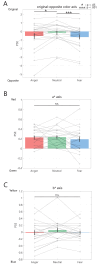Facial expressions affect the memory of facial colors
- PMID: 38814935
- PMCID: PMC11148839
- DOI: 10.1167/jov.24.5.14
Facial expressions affect the memory of facial colors
Abstract
Facial color influences the perception of facial expressions, and emotional expressions bias how facial color is remembered. However, it remains unclear whether facial expressions affect daily facial color memory. The memory color effect demonstrates that knowledge about typical colors affects the perception of the actual color of given objects. To investigate the effect of facial color memory, we examined whether the memory color effect for faces varies depending on facial expression. We calculated the subjective achromatic point of the facial expression image stimulus and compared the degree to which it was shifted from the actual achromatic point between facial expression conditions. We hypothesized that if the memory of facial color is influenced by the facial expression color (e.g., anger is a warm color, fear is a cold color), then the subjective achromatic point would vary with facial expression. In Experiment 1, we recruited 13 participants who adjusted the color of facial expression stimuli (anger, neutral, and fear) and a banana stimulus to be achromatic. No significant differences in the subjective achromatic point between facial expressions were observed. Subsequently, we conducted Experiment 2 with 23 participants because Experiment 1 did not account for the sensitivity to color changes on the face; humans perceive greater color differences in faces than in non-faces. Participants selected which facial color they believed the expression stimulus appeared to be, choosing one of two options provided to them. The results indicated that the subjective achromatic points of anger and fear faces significantly shifted toward the opposite color direction compared with neutral faces in the brief presentation condition. This research suggests that the memory color of faces differs depending on facial expressions and supports the idea that the perception of emotional expressions can bias facial color memory.
Figures






Similar articles
-
Interaction between Facial Expression and Color in Modulating ERP P3.eNeuro. 2025 Jan 10;12(1):ENEURO.0419-24.2024. doi: 10.1523/ENEURO.0419-24.2024. Print 2025 Jan. eNeuro. 2025. PMID: 39794119 Free PMC article.
-
Interaction between facial expression and color.Sci Rep. 2017 Jan 24;7:41019. doi: 10.1038/srep41019. Sci Rep. 2017. PMID: 28117349 Free PMC article.
-
Not on the face alone: perception of contextualized face expressions in Huntington's disease.Brain. 2009 Jun;132(Pt 6):1633-44. doi: 10.1093/brain/awp067. Epub 2009 May 18. Brain. 2009. PMID: 19451178 Free PMC article.
-
Contextual effects of angry vocal expressions on the encoding and recognition of emotional faces: An event-related potential (ERP) study.Neuropsychologia. 2019 Sep;132:107147. doi: 10.1016/j.neuropsychologia.2019.107147. Epub 2019 Jul 17. Neuropsychologia. 2019. PMID: 31325481
-
Early Maladaptive Schemas and the Accuracy of Facial Emotion Recognition: A Preliminary Investigation.Psychol Rep. 2023 Aug;126(4):1585-1604. doi: 10.1177/00332941221075248. Epub 2022 Mar 2. Psychol Rep. 2023. PMID: 35084239 Review.
Cited by
-
Interaction between Facial Expression and Color in Modulating ERP P3.eNeuro. 2025 Jan 10;12(1):ENEURO.0419-24.2024. doi: 10.1523/ENEURO.0419-24.2024. Print 2025 Jan. eNeuro. 2025. PMID: 39794119 Free PMC article.
References
-
- Dal Ben, R. (2021). SHINE_color: Controlling low-level properties of colorful images, 10.31234/OSF.IO/FEC6X. - DOI - PMC - PubMed
-
- Han, C., Wang, H., Hahn, A. C., Fisher, C. I., Kandrik, M., Fasolt, V., ... Jones, B. C. (2018). Cultural differences in preferences for facial coloration. Evolution and Human Behavior, 39(2), 154–159, 10.1016/J.EVOLHUMBEHAV.2017.11.005. - DOI
MeSH terms
LinkOut - more resources
Full Text Sources
Medical

